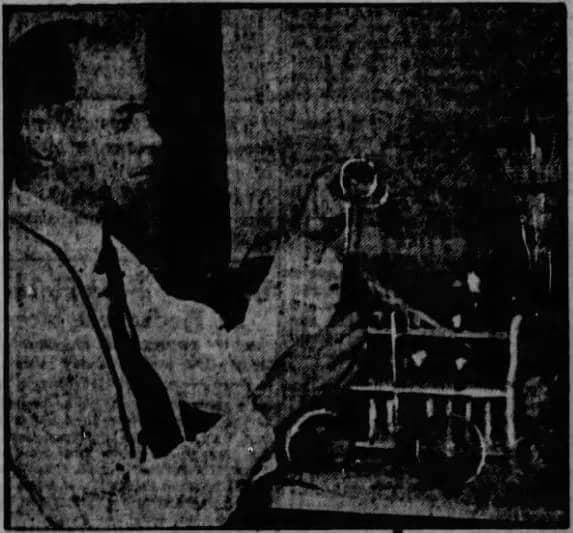
I mentioned in Luke S. May in my last Saturday Post of 2023. I talked about having noticed the name in relation to the Erland’s Point Massacre( & part 2), which was quite the ordeal when it occurred here in Bremerton 90 years ago.
That story is itself fascinating, and as I’ve poked around researching it I found myself drawn to the Luke S. May, having read his name many times as I’ve poked around in this region’s history. His name is even prominently displayed in a headline framed in the bathroom at the Remedy Speakeasy on 4th Street in Bremerton.
I noticed that at the time his is called Luke S. May, Chief of Detectives for the Seattle Police Department, which seemed like a shift from having seen his name and title mostly as “Luke S. May, Criminologist” in the early 1920s. He’s also called Detective, Head of Revelare Agency (Revelare International Secret Service, found in 1914), and sometimes President of the Association of Sheriffs and Police (an impressive position to be elected to given he was neither at the time).
I’ve only just begun to scratch the surface this man’s career after moving to Seattle in 1919 from Pocatello, Idaho and it has been a lot of fun.
I love history, I love to learn about history, read about history, so I’ve been having a good time learning about all the cases and stories to which he’s been connected.
Just going through search results on Newspapers.com has given me a ton of interesting stories of the time. Luke May starts showing up in search results in about 1921- though I’m sure I’ll find some earlier mentions. He’s often noted for having given some testimony and forensic evidence. He’s noted for his tools and certainty. And given his role at the time of trying to prove things scientifically, it’s amazing to see him providing these services before law enforcement established their own criminal labs.
Having only gotten through a good amount of 1921 and 1922 I’ve found myself sidetracked by the cases and how they played out and were reported. There’s a posse that went after the “Beast-Man” who attacked the window O’Hare’s family where Luke May was gathering fingerprint evidence to identify the suspect once caught, the letter he received from Russian criminals giving up the contract killers they’d hired to kill Nicholas Koleski, an Aberdeen patrolman and Canadian WWI hero, who was probing their booze smuggling, and the fascinating tale of Clara Skarin, killer of Ferdinand Hochbrunn in 1921, who was referred to as ‘the girl who smiles’ in the papers at the time. Luke May was called in, though to be honest I’m still not sure how he was connected. Spoiler alert: despite having admitted to killing Hochbrunn, Ms. Skarin was ultimately acquitted of the crime.
It was also reported about the classes he would hold at Kiwani’s Clubs talking about how prevalent crimes and drugs were, his leading the formation of a information and statistical bureau to combat narcotic evil, and a Radio Network he formed to help coordinate between various agencies in the region.
Another very interesting story is that of the murder of Officer Charles O. Legate and just what a huge deal that story was at the time. His murder was originally deemed a suicide by the coroner but, after his widow asked for the help of the first woman to practice law in Seattle Lady Willie Forbus (who would go on to be the first woman to represent the 44th District in the state Senate - her life was quite fascinating as well) to prove that it was murder so that she could get Legate’s pension. It would be Luke S. May, with his “Revelarescope” (a split image projection device), who would provide proof that bullets in Legate’s head came from two different guns. Additionally, the garage where he was found was locked from the outside, further precluding the notion of a suicide.
Following Legate’s death William B. Severyns was appointed to be the Police Chief and to clean up the Seattle Police Department.
The crime was never publicly solved, but Severyns would write later that it might have been “a quarrel over the division of spoils. There had been hard feelings between Legate, other policemen, and other underworld characters, and … Legate had threatened to squeal. One of two men, or both, did the shooting. One of these men was a policeman. The other was an underworld character, a dealer in liquor and dope”.
Seattle was a very different place 100 years ago for sure, and newspapers were very different as well. The stories and sentiments, however, still hit remarkably close to home today. Concerns over crime, homelessness, safety, wages, and illness, for example, read very similar in then as they do now.
As I wrap up this post, it’s clear that the story of Luke S. May is far from finished in my eyes. This journey through the annals of history has only just begun, and with each page turned, May’s life and career continue to unfold in fascinating ways.
I’m eager to delve deeper into his investigative methods and his significant role in the historical narrative of our region. Particularly intriguing is the prospect of exploring his contributions to ‘True Detective Mysteries,’ which promises a rich trove of ‘true crime’ stories to unearth.
So, consider this not as a conclusion, but as a pause in an ongoing dialogue. In my future posts, I anticipate bringing more of May’s world to light, sharing his stories, and perhaps even drawing parallels with our present. Stay tuned, for history, as it turns out, is a tale that never truly ends.